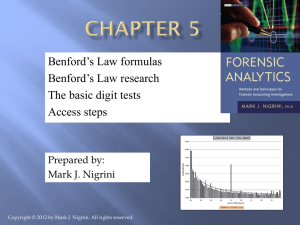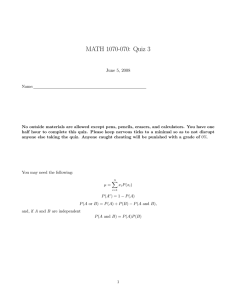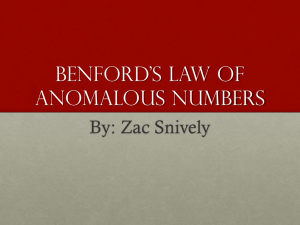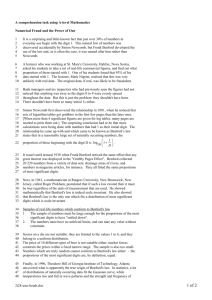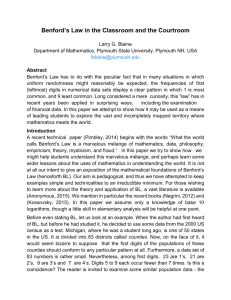Breaking the (Benford) Law: Statistical Fraud
advertisement
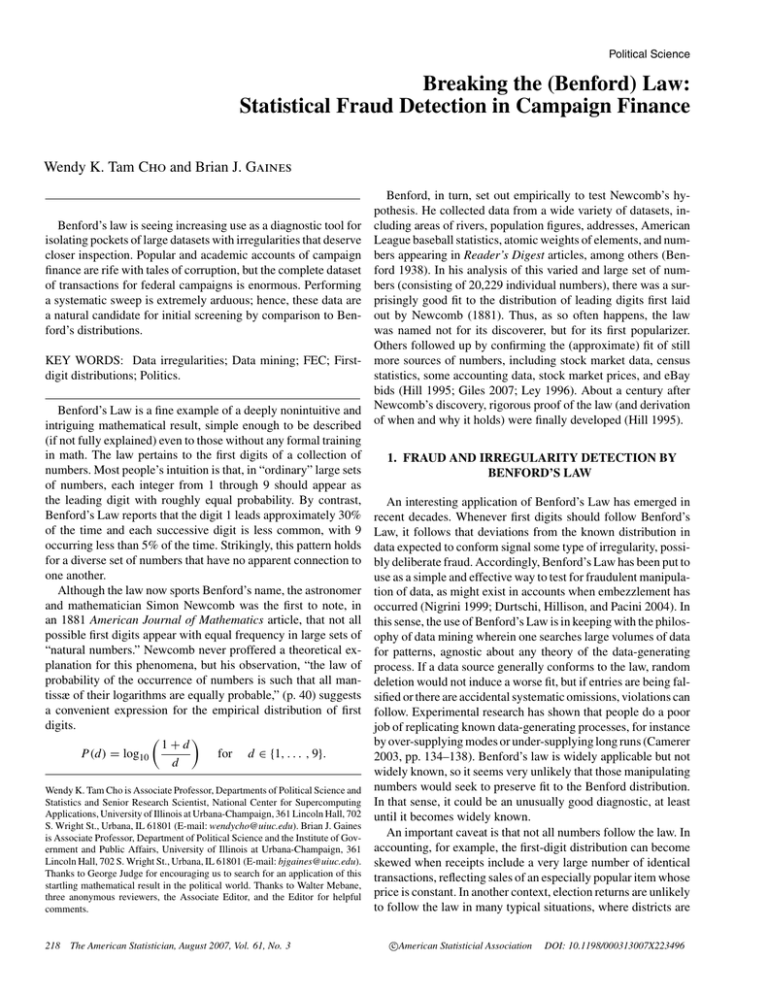
Political Science
Breaking the (Benford) Law:
Statistical Fraud Detection in Campaign Finance
Wendy K. Tam Cho and Brian J. Gaines
Benford’s law is seeing increasing use as a diagnostic tool for
isolating pockets of large datasets with irregularities that deserve
closer inspection. Popular and academic accounts of campaign
finance are rife with tales of corruption, but the complete dataset
of transactions for federal campaigns is enormous. Performing
a systematic sweep is extremely arduous; hence, these data are
a natural candidate for initial screening by comparison to Benford’s distributions.
KEY WORDS: Data irregularities; Data mining; FEC; Firstdigit distributions; Politics.
Benford’s Law is a fine example of a deeply nonintuitive and
intriguing mathematical result, simple enough to be described
(if not fully explained) even to those without any formal training
in math. The law pertains to the first digits of a collection of
numbers. Most people’s intuition is that, in “ordinary” large sets
of numbers, each integer from 1 through 9 should appear as
the leading digit with roughly equal probability. By contrast,
Benford’s Law reports that the digit 1 leads approximately 30%
of the time and each successive digit is less common, with 9
occurring less than 5% of the time. Strikingly, this pattern holds
for a diverse set of numbers that have no apparent connection to
one another.
Although the law now sports Benford’s name, the astronomer
and mathematician Simon Newcomb was the first to note, in
an 1881 American Journal of Mathematics article, that not all
possible first digits appear with equal frequency in large sets of
“natural numbers.” Newcomb never proffered a theoretical explanation for this phenomena, but his observation, “the law of
probability of the occurrence of numbers is such that all mantissæ of their logarithms are equally probable,” (p. 40) suggests
a convenient expression for the empirical distribution of first
digits.
1+d
P (d) = log10
for d ∈ {1, . . . , 9}.
d
Wendy K. Tam Cho is Associate Professor, Departments of Political Science and
Statistics and Senior Research Scientist, National Center for Supercomputing
Applications, University of Illinois at Urbana-Champaign, 361 Lincoln Hall, 702
S. Wright St., Urbana, IL 61801 (E-mail: wendycho@uiuc.edu). Brian J. Gaines
is Associate Professor, Department of Political Science and the Institute of Government and Public Affairs, University of Illinois at Urbana-Champaign, 361
Lincoln Hall, 702 S. Wright St., Urbana, IL 61801 (E-mail: bjgaines@uiuc.edu).
Thanks to George Judge for encouraging us to search for an application of this
startling mathematical result in the political world. Thanks to Walter Mebane,
three anonymous reviewers, the Associate Editor, and the Editor for helpful
comments.
218 The American Statistician, August 2007, Vol. 61, No. 3
Benford, in turn, set out empirically to test Newcomb’s hypothesis. He collected data from a wide variety of datasets, including areas of rivers, population figures, addresses, American
League baseball statistics, atomic weights of elements, and numbers appearing in Reader’s Digest articles, among others (Benford 1938). In his analysis of this varied and large set of numbers (consisting of 20,229 individual numbers), there was a surprisingly good fit to the distribution of leading digits first laid
out by Newcomb (1881). Thus, as so often happens, the law
was named not for its discoverer, but for its first popularizer.
Others followed up by confirming the (approximate) fit of still
more sources of numbers, including stock market data, census
statistics, some accounting data, stock market prices, and eBay
bids (Hill 1995; Giles 2007; Ley 1996). About a century after
Newcomb’s discovery, rigorous proof of the law (and derivation
of when and why it holds) were finally developed (Hill 1995).
1. FRAUD AND IRREGULARITY DETECTION BY
BENFORD’S LAW
An interesting application of Benford’s Law has emerged in
recent decades. Whenever first digits should follow Benford’s
Law, it follows that deviations from the known distribution in
data expected to conform signal some type of irregularity, possibly deliberate fraud. Accordingly, Benford’s Law has been put to
use as a simple and effective way to test for fraudulent manipulation of data, as might exist in accounts when embezzlement has
occurred (Nigrini 1999; Durtschi, Hillison, and Pacini 2004). In
this sense, the use of Benford’s Law is in keeping with the philosophy of data mining wherein one searches large volumes of data
for patterns, agnostic about any theory of the data-generating
process. If a data source generally conforms to the law, random
deletion would not induce a worse fit, but if entries are being falsified or there are accidental systematic omissions, violations can
follow. Experimental research has shown that people do a poor
job of replicating known data-generating processes, for instance
by over-supplying modes or under-supplying long runs (Camerer
2003, pp. 134–138). Benford’s law is widely applicable but not
widely known, so it seems very unlikely that those manipulating
numbers would seek to preserve fit to the Benford distribution.
In that sense, it could be an unusually good diagnostic, at least
until it becomes widely known.
An important caveat is that not all numbers follow the law. In
accounting, for example, the first-digit distribution can become
skewed when receipts include a very large number of identical
transactions, reflecting sales of an especially popular item whose
price is constant. In another context, election returns are unlikely
to follow the law in many typical situations, where districts are
c
American
Statisticial Association
DOI: 10.1198/000313007X223496
of nearly equal size and the level of competition conspires to
fix most vote totals in a limited range. Taking the top three vote
getters in all 2002 U.S. House elections, almost 38% of the vote
totals had 1 as the leading digit, while 4 was next most common,
at about 12%. On the other hand, vote totals in pre-existing geographic units that are not artificially constructed subject to an
equal-size constraint (such as counties) conform to Benford’s
Law much better.
Benford’s Law is more “robust” than one might imagine. For
instance, while not all numbers will conform to the Benford
distribution, if distributions are randomly selected and random
samples are taken from each of the distributions, then the frequency of digits of this combined set will converge to Benford’s
distribution even if the separate distributions deviate from Benford’s distribution (Hill 1995, 1998).
Durtschi, Hillison, and Pacini (2004) provided guidelines on
when to expect Benford compliance.
1. Numbers that result from mathematical combination of
numbers (e.g., quantity × price)
(FEC) has made a practice of posting all reports to public electronic databases. A simple method of examining FEC data for
signs of fraud is appealing partly because the very reason the
FEC provides these data to the public is to guard against abuses
of the system. By its very existence, the FEC archive enlists all
interested parties in the task of monitoring the flow of money in
federal elections.
In general, however, the FEC data archive would not seem to
be a good prospect for data that follow Benford’s Law because of
numerous laws regulating political contributions. For instance,
individuals have historically been limited to donating a maximum of $2,000 to federal candidates per election cycle ($1,000
designated for the primary campaign and $1,000 for the general
campaign). A large proportion of all donors give the maximum
amount, making the number 1 even more modal than usual in
the donation records. The data, in other words, violate item 3 in
the checklist above.
2.1
In-Kind Contributions and Joint Fundraising Committees
2. Transaction-level data (e.g., disbursements, sales)
3. Large datasets
4. Mean is greater than median and skew is positive
On the flip side, numbers that would not follow Benford’s Law
have the following characteristics.
1. Numbers are assigned (e.g., check numbers, invoice numbers)
2. Numbers influenced by human thought (e.g., prices set by
psychological thresholds ($1.99))
3. Accounts with a large number of firm-specific numbers
(e.g., accounts set up to record $100 refunds)
4. Accounts with a built-in minimum or maximum
5. Where no transaction is recorded
These restrictions apply to many data sources, and clearly comparison to Benford’s proportions is not always warranted. Although interesting applications of Benford’s Law have emerged,
few have ventured into the world of politics where corruption
of various kinds is commonly alleged. If history is any guide,
there must be myriad instances where one will be astonished by
Benford’s applicability in the political realm. Here, we explore
data on campaign finance, a field rife with allegations of fraud,
cheating, and corruption.
2. FEC FILINGS
Campaign finance regulations are nearly a century old, and the
long history of ever-changing laws and scandals, large and small,
suggests that incentives to slip through loopholes and twist (or
ignore) restrictions are a persistent feature of competitive politics. The data describing most financial transactions undertaken
by candidates seeking federal office have, in recent years, become fairly easy to access, as the Federal Election Commission
One variety of transaction that might escape this tendency to
cluster is the in-kind contribution. In general, individuals are permitted to donate services to candidates without fixing a dollar
amount on their efforts. Thus, volunteers can work as many hours
as they please for a congressional campaign without running
afoul of FEC regulations. However, under some circumstances,
donors must declare a cash value for services or goods donated
to a campaign. When a third party pays the bills on behalf of
a campaign committee (whether the recipient is a celebrity performing for a fee, a commercial landlord collecting rent, etc.),
the individual footing the bill is making an in-kind donation to
the campaign. If an organization puts paid workers at the service
of a campaign, the total wage bill represents an in-kind donation. All such donations are subject to the same limits as cash
contributions. The key aspect of in-kind donations for present
purposes is that they seem comparatively unlikely to cluster at
the maximum permitted value, since they are often computed
according to retail prices or pre-set wages and hours worked.
In addition, the limits mentioned above apply to donations to
candidate committees, but not to donations of so-called “soft”
money to party committees. Candidates generally accept donations through campaign committees, however, they can also set
up “Joint Fundraising” committees (JFC) that raise both regulated (“hard money”) contributions and soft money simultaneously. The JFCs, in turn, redistribute the money, generally
by passing on the maximum permitted amount to the candidate
committee as hard money, and then channeling the balance to a
party committee as soft money. Hence, the category of in-kind
contributions to joint fundraising committees represents an unusual subset of the FEC domain, since neither contribution limits
nor round-value focal points constrain the data strongly.
One high-profile scandal involving alleged fraud in campaign
accounting involved Hillary Clinton, and revolved around inkind donations to a JFC. In January 2005, David Rosen, the Director of Finance for Clinton’s 2000 Senatorial campaign, was
indicted on four counts of causing false campaign finance reports to be filed with the FEC. Prosecutors alleged that Rosen
The American Statistician, August 2007, Vol. 61, No. 3 219
Table 1. Committee-to-committee in-kind contributions (first digits), 1994–2004.
Newcomb
Benford data
1994
30.1
17.6
12.5
9.7
7.9
6.7
5.8
5.1
4.6
28.9
19.5
12.7
9.1
7.5
6.4
5.4
5.5
5.1
32.9
18.7
13.6
7.9
8.9
8.3
4.1
2.4
3.2
24.4
21.7
15.8
9.6
10.2
6.3
4.8
3.2
4.0
27.4
18.5
15.3
10.3
11.8
5.9
3.7
3.9
3.3
26.4
21.1
11.1
10.7
10.1
4.3
6.4
2.4
7.5
24.9
22.6
10.7
11.6
10.5
4.3
3.4
3.0
9.0
23.3
21.1
8.5
11.7
9.5
4.2
3.7
4.0
14.1
N
20,229
9,632
11,108
9,694
10,771
10,348
8,396
χ2
VN∗
d∗
85.1
2.9
0.024
349
5.7
0.052
507
10.1
0.081
431
8.1
0.061
4,823
5.5
0.071
1,111
7.8
0.097
2,181
8.7
0.131
1
2
3
4
5
6
7
8
9
repeatedly and knowingly under-reported in-kind contributions
to New York Senate 2000, Clinton’s JFC (Tonken 2004). The
main incentive for such obfuscation would have been that FEC
rules at the time allowed candidates to pay for fundraising events
with soft money provided that the costs were no more than 40%
of the total hard money raised. Thus, minimizing costs allowed
the Clinton campaign to preserve precious hard money, which
could be used for direct campaign advertisements in the bruising and expensive air war that lay ahead. Rosen faced up to five
years in prison, but was acquitted. The defense, accepted by the
jury, did not deny fraud and shoddy accounting, but blamed others, claiming that Rosen was unaware of the shenanigans (Ryan
2005).
Unfortunately, although the FEC is diligent about collecting
and posting candidate reports, the data are not coded in such a
way that one can easily identify in-kind donations, let alone inkind donations to JFCs. For obscure reasons, the only in-kinds
that are distinctly marked are those made from one committee
(as opposed to an individual) to another committee. The reasons
money is shuffled between committees are, again, somewhat
arcane, and related to the fact that campaign finance regulations
are: (a) ever-changing, as they seem almost without exception
to produce some unintended consequences; (b) constrained in
several manners by a tangled jurisprudence incorporating, for
instance, first-amendment protection of political speech; and (c)
created by plainly not disinterested actors, namely incumbent
politicians.
3. ANALYSIS OF IN-KIND CONTRIBUTIONS
The data reported in Table 1 are the first digit relative frequencies (as percentages) for all committee-to-committee, inkind contributions cataloged by the FEC for each of the last six
election cycles. For comparison, the second column shows the
values for the 20 datasets Benford discussed in his 1938 paper.
A casual perusal reveals that fit to the Newcomb-Benford theoretical distribution for the FEC data seems to have gotten worse
over time. Figure 1 is a graphical depiction of the data’s conformity. In each plot, the expected “Benford’s law” values are
220 Interdisciplinary: Political Science
1996
1998
2000
2002
2004
plotted by the solid line. The first plot covers the elections of
1994, 1996, and 1998. The second plot pertains to contributions
from the 2000, 2002, and 2004 election cycles. On average, the
fit to Benford seems to have become poorer in the more recent
elections. The figure makes clear, for instance, that since 2000,
each election has seen an increasing surplus of leading 9s. Leading 1s, by contrast, are too few in number, and in decline over
these three elections.
To make these comparisons more precise, one can compute
formal test statistics. One alternative is to conduct a χ 2 goodnessof-fit test. The null hypothesis is that the data follow the Benford
distribution, shown in the column labeled “Newcomb” in Table 1.
The test statistic is
χ2 =
k
(Oi − Ei )2
,
Ei
i=1
where Oi and Ei are the observed and expected frequencies for
digit i, respectively. The test statistic follows a χ 2 distribution
with 8 degrees of freedom, so the null hypothesis is rejected if
2 , where α is the level of significance. As the table
χ 2 > χα,8
shows, for every year we analyze, the χ 2 test produces huge values that lead one to reject the null hypothesis at any conceivable
significance level (the critical value for the 0.001-level here is
26). Indeed, one can reject the null hypothesis for the very data
that Benford used to demonstrate the accuracy of Newcomb’s
law. Of course, χ 2 tests are very sensitive to sample size, having
enormous power for large N, so that even quite small differences will be statistically significant. This test appears to be too
rigid to assess goodness-of-fit well, especially since the Benford
proportions do not represent a true distribution that one would
expect to occur in the limit (Ley 1996; Giles 2007).
A second alternative is a modified Kolmogorov-Smirnov test
statistic (Kuiper 1962),
+
−
VN = DN
+ DN
,
where
+
DN
=
sup
−∞<x<∞
[FN (x) − F0 (x)] ,
Figure 1.
In-kind contributions and Benford’s Law.
and
−
=
DN
sup
−∞<x<∞
[F0 (x) − FN (x)] .
Giles (2007), citing Stephens (1970), favors a modified form of
the VN test statistic, VN∗ , which is independent of sample size
and has critical value of 2.001 for α = 0.001. The table shows
that our values for VN∗ , like the χ 2 values, lead us to reject conformity with Benford’s law for all of our FEC datasets. Again,
though, we would also reject the null hypothesis for Benford’s
data on the basis of this test, suggesting that perhaps it is too
rigid. The very naming of the “law” after Benford reflects the
common understanding that he demonstrated that Newcomb’s
idea is widely applicable to real-world data, not the contrary.
Since no one has suggested that Benford’s Law holds asymptotically, a preferable statistic would be less sensitive to sample size
than the χ 2 statistic. Arguably, it is also not a natural context for
computing p values.
One other possible measure of fit, then, not connected to a
hypothesis-testing framework and insensitive to sample size, is
based on Euclidean distance from Benford’s distribution in the
nine-dimensional space occupied by any first-digit vector. Here,
let
9
d = (pi − bi )2 ,
i=1
where pi and bi are the proportions of observations having i as
the leading digit and expected by Benford’s distribution, respectively. Because these vectors are compositional, we can compute the maximum possible distance, associated with a distribution where the first digit expected to occur least often (9) is the
only one observed. Division by this maximum value converts
the distance-from-Benford value, d, for any given empirical distribution to a score bounded by 0 and 1. The bottom row of
the table shows these scores (labeled “d ∗ ”). Again, the last two
elections stand out as exhibiting somewhat worse fit than their
earlier counterparts, and the Benford data provide a rough sense
for what constitutes a realistic, small value.
None of these figures, of course, pinpoint why the data describing in-kind contributions for the latter elections have departed
from the prior pattern of loose fit to Benford’s law. This analysis
merely identifies the years as anomalous and worthy of further
inspection. The origin of the poor fit to Benford’s law could be
bad record keeping, new practices in donations that correspond
to the checklist of Benford inapplicability, changes associated
with the “McCain-Feingold” Bipartisan Campaign Reform Act,
or increasing incidence of actual fraud or other irregularity in
financial transactions.
To explore further when and how discrepancies between actual
data and the theory occur, one can examine subsets of the data.
Indeed, there is an especially strong rationale for re-examining
the data by size of contribution. Thus far we have followed common practice by neglecting a point Benford emphasized in his
1938 article, that the Newcomb distribution is a “law for large
numbers” (p. 554). Benford derived alternative distributions for
numbers having only one-, two-, or three- digits, since the “limiting order” routinely described as “Benford’s distribution” turns
out to be a crude approximation for such small numbers.
In Table 2 we disaggregate the FEC data according to the size
of the contribution, and we report Benford’s theoretical distributions for one-, two-, and three- digit numbers, to which the
FEC data can be compared. (For each of these distributions, we
also report their standardized distance from the familiar, large-N
Benford distribution in the d ∗ column.) It is evident, and not terribly surprising, that fit is always worse in subsets (as compared
with the totals in Table 1). Aggregation plays no small part in the
Benford tendency. The other main pattern is that fit is generally
poor for the one-digit numbers and the four-or-more-digit numbers, and better for the intermediate categories. A striking oddity
is that 2000 bears little resemblance to the other election years
in regard to the smallest contributions—it has by far the best fit
to the one-digit theory because of a large number of (inherently
suspicious) $1 transactions. A second interesting trait, worthy of
further investigation, is that the increase in leading 9s over the
last three election cycles is largely due to $90–$99 contributions.
Although how best to generalize the distance score to acknowledge the fact that the predicted values are now a 9 × 4 matrix
The American Statistician, August 2007, Vol. 61, No. 3 221
Table 2. In-kind contributions by contribution size.
N
d∗
1
2
3
4
5
6
7
8
9
0.393
0.318
0.303
0.301
0.258
0.179
0.176
0.176
0.133
0.124
0.125
0.125
0.082
0.095
0.097
0.097
0.053
0.076
0.079
0.079
0.036
0.064
0.067
0.067
0.024
0.054
0.058
0.058
0.015
0.047
0.051
0.051
0.007
0.042
0.045
0.046
$1 – $ 9
$10 – $ 99
$100 – $ 999
$1000+
0.090
0.349
0.305
0.579
0.067
0.206
0.187
0.190
0.073
0.126
0.153
0.108
0.060
0.083
0.077
0.081
0.062
0.083
0.104
0.027
0.502
0.047
0.075
0.000
0.054
0.051
0.038
0.001
0.034
0.027
0.023
0.011
0.058
0.027
0.038
0.001
536
3,493
4,902
701
0.535
0.051
0.055
0.294
$1 – $ 9
$10 – $ 99
$100 – $ 999
$1000+
0.057
0.159
0.259
0.558
0.116
0.218
0.226
0.191
0.210
0.154
0.172
0.073
0.099
0.096
0.090
0.127
0.080
0.109
0.108
0.044
0.080
0.088
0.056
0.002
0.080
0.085
0.028
0.005
0.077
0.048
0.024
0.000
0.202
0.043
0.036
0.000
352
3,875
5,925
956
0.389
0.166
0.093
0.278
$1 – $ 9
$10 – $ 99
$100 – $ 999
$1000+
0.101
0.188
0.282
0.548
0.084
0.144
0.192
0.306
0.054
0.192
0.158
0.039
0.027
0.105
0.113
0.065
0.104
0.110
0.141
0.039
0.191
0.100
0.037
0.001
0.054
0.060
0.029
0.001
0.289
0.046
0.027
0.000
0.097
0.054
0.022
0.000
298
3,305
5,017
1,074
0.437
0.153
0.090
0.305
$1 – $ 9
$10 – $ 99
$100 – $ 999
$1000+
0.427
0.184
0.249
0.560
0.036
0.213
0.203
0.308
0.056
0.101
0.142
0.045
0.021
0.077
0.154
0.050
0.053
0.105
0.117
0.036
0.167
0.045
0.040
0.000
0.062
0.101
0.047
0.001
0.058
0.031
0.021
0.000
0.120
0.144
0.027
0.000
468
4,297
4,855
1,151
0.274
0.176
0.100
0.316
$1 – $ 9
$10 – $ 99
$100 – $ 999
$1000+
0.034
0.195
0.250
0.543
0.073
0.206
0.234
0.316
0.069
0.124
0.107
0.040
0.019
0.078
0.172
0.041
0.203
0.097
0.118
0.057
0.165
0.051
0.038
0.000
0.119
0.038
0.032
0.000
0.111
0.030
0.031
0.001
0.207
0.181
0.018
0.002
261
4,356
4,760
971
0.466
0.183
0.123
0.307
$1 – $ 9
$10 – $ 99
$100 – $ 999
$1000+
0.035
0.165
0.238
0.490
0.031
0.155
0.231
0.359
0.040
0.089
0.095
0.040
0.035
0.071
0.180
0.043
0.256
0.055
0.129
0.064
0.172
0.052
0.035
0.002
0.154
0.041
0.037
0.000
0.181
0.055
0.027
0.002
0.097
0.316
0.028
0.000
227
3,345
3,836
988
0.495
0.305
0.136
0.292
Benford (i < 10)
Benford (9 < i < 100)
Benford (99 < i < 1000)
Newcomb-Benford (i > 999)
0.140
0.018
0.002
1994
1996
1998
2000
2002
2004
Note: i denotes contribution amounts in whole dollars.
rather than a 9-tuple is not self-evident, if one simply computes
weighted averages of the distance for each subset, then, once
again, the 2004 data seem to offer markedly worse conformity
to Benford’s distributions (the values are, in order, from 1994 to
2004: 0.097; 0.144; 0.146; 0.161; 0.174; 0.231). A Cox-Stuart
test for trend using all 24 d ∗ values indicates that the last three
years, when blocked by level of contribution, have seen significantly worse fit to Benford (p < 0.001).
4. CONCLUSION
Benford’s Law is a powerful, objective, simple, and effective
tool for identifying anomalies in data. It is especially valuable
for large datasets on deception-prone activities. Comparison of
empirical data to these theoretical distributions will not usually locate a “smoking gun,” but it can be a good diagnostic for
where to go sniffing for that gun. This is how Benford’s Law is
currently used in contexts such as tax auditing (Nigrini 1996).
The ability to ferret through millions of tax returns—or campaign contributions—quickly to identify a suspicious set clearly
enhances efficiency. Moreover, Benford’s Law is applicable to
222 Interdisciplinary: Political Science
surprisingly large and diverse classes of data. Recent applications include self-reported toxic emmissions data (de Marchi
and Hamilton 2006), quality of survey data (Judge and Schechter
2006), and election returns (Mebane 2006).
Of course, first-digit laws are not universally applicable, so
other tools are necessary for particular applications. Where
cheating is a temptation for test administrators, runs tests and
applications of simple combinatorics have proven useful (Jacob and Levitt 2003). In campaign finance, because most FEC
records seem likely to violate Benford because of predictable
modes caused by regulation, data mining techniques are helpful to screen for suspicious subsets. Benford’s Law is only one
of many tools for identifying patterns. In its favor, Benford’s
Law concerns a pattern in the data known at the outset, making
it unusually easy to implement. Grendar, Judge, and Schechter
(2007) have proposed alternative formulations for first significant digit distributions, and set forth a theoretical model wherein
the Benford distribution is regarded as one member of a family
of distributions of first-significant-digit occurrence rates. Their
framework allows a considerable broadening of the Benford test.
One might also broaden the scope of Benford in the FEC data
archive, for instance, by partitioning the in-kind data by state,
recipient committee, party of the candidates, and so on. Benford
also derived a nonuniform distribution for second digits, and
the first- and second-digit distributions are not independent, so
comparison of data to their joint distribution might prove fruitful
in some contexts. In the end, all of these tests are primarily
helpful in identifying cases that warrant closer inspection, and
their main attraction is speed and efficiency. Organizations like
the FEC, that post very large quantities of data, should consider
implementing tests of this kind as a routine procedure, to ensure
the quality of their data, which may be compromised by any
number of recording issues unrelated to fraud.
The preliminary analysis reported above does not constitute
proof of illegality, but we have identified pockets of data that
merit more careful inspection. We have suggested that the most
suitable subset of the FEC archive for first-digit checks is probably in-kind contribution to JFCs, a large class of transactions
that, unfortunately, is not presently identifiable. We look forward
to better data collection and processing practices by the FEC to
facilitate more careful scrutiny of these important data.
[Received April 2006. Revised April 2007.]
REFERENCES
Benford, F. (1938), “The Law of Anomalous Numbers,” Proceedings of the
American Philosophical Society, 78, 551–572.
Camerer, C. F. (2003), Behavioral Game Theory: Experiments in Strategic Interaction, New York, NY: Russell Sage Foundation and Princeton University
Press.
de Marchi, S., and Hamilton, J. (2006), “Assessing the Accuracy of Self-Reported
Data: An Evaluation of the Toxics Release Inventory,” Journal of Risk and
Uncertainty, 32, 57–76.
Durtschi, C., Hillison, W., and Pacini, C. (2004), “The Effective Use of Benford’s
Law to Assist in Detecting Fraud in Accounting Data,” Journal of Forensic
Accounting, 5, 17–34.
Giles, D. E. A. (2007), “Benford’s Law and Naturally Occurring Prices in Certain
e-Bay Auctions,” Applied Economics Letters, 14, 157–161.
Grendar, M., Judge, G., and Schechter, L. (2007), “An Empirical Non-parametric
Likelihood Family of Data-based Benford-like Distributions,” Physica A,
380, 429–438.
Hill, T. P. (1995), “A Statistical Derivation of the Significant Digit Law,” Statistical Science, 10, 354–363.
(1998), “The First Digit Phenomenon,” American Scientist, 86, 358–
363.
Jacob, B. A., and Levitt, S. D. (2003), “Rotten Apples: An Investigation of
the Prevalence and Predictors of Teacher Cheating,” Quarterly Journal of
Economics, 118, 843–877.
Judge, G., and Schechter, L. (2006), “Detecting Problems in Survey Data Using
Benford’s Law,” working paper.
Kuiper, N. H. (1962), “Tests Concerning Random Points on a Circle,” Proceedings of the Koninkl. Nederl. Akad. van Wetenschappen, Ser. A, 63, 38–47.
Ley, E. (1996), “On the Peculiar Distribution of the U.S. Stock Indexes’ Digits,”
The American Statistician, 50, 311–313.
Mebane, W. R. (2006), “Election Forensics: The Second-Digit Benford’s Law
Test and Recent American Presidential Elections,” working paper.
Newcomb, S. (1881), “Note on the Frequency of Use of the Different Digits in
Natural Numbers,” American Journal of Mathematics, 4, 39–40.
Nigrini, M. J. (1996), “Taxpayer Compliance Application of Benford’s Law,”
Journal of the American Taxation Association, 18, 72–92.
(1999), “Adding Value with Digital Analysis,’ The Internal Auditor, 56,
21–23.
Ryan, J. (2005), “Rosen Acquittal Puts Focus on Lawyer’s Skills,” Los Angeles
Daily Journal, Tuesday May 31.
Stephens, M. A. (1970), “Use of the Kolmogorov-Smirnov, Cramér-von Mises
and Related Statistics Without Extensive Tables,” Journal of the Royal Statistical Association, Series B, 32, 115–122.
Tonken, A. (2004), King of Cons: Exposing the Dirty Rotten Secrets of the
Washington Elite and Hollywood Celebrities, Nashville, TN: Nelson Current.
The American Statistician, August 2007, Vol. 61, No. 3 223
